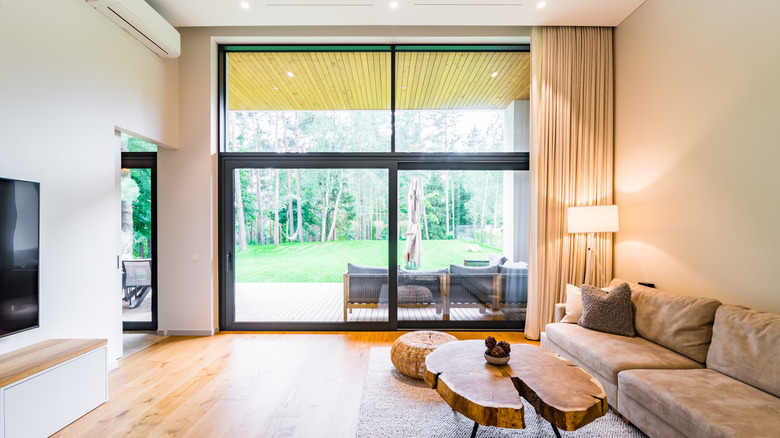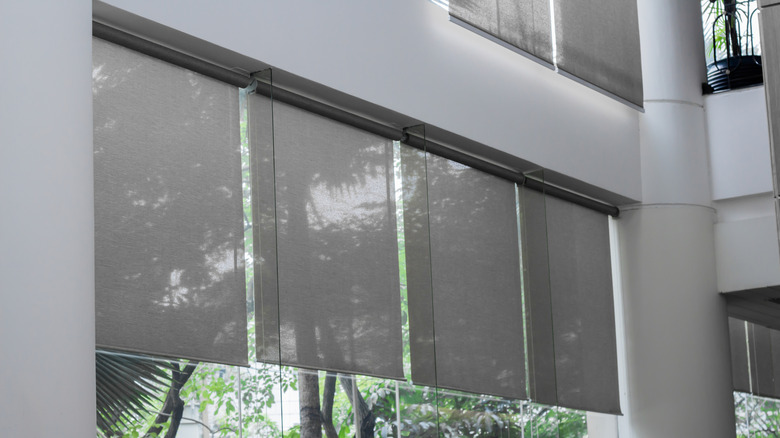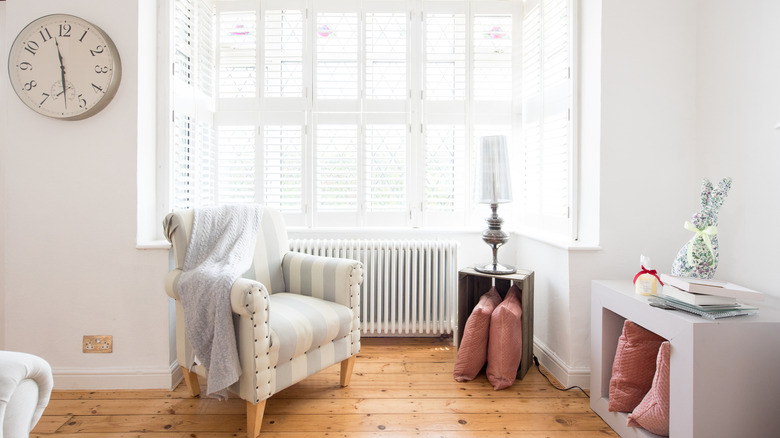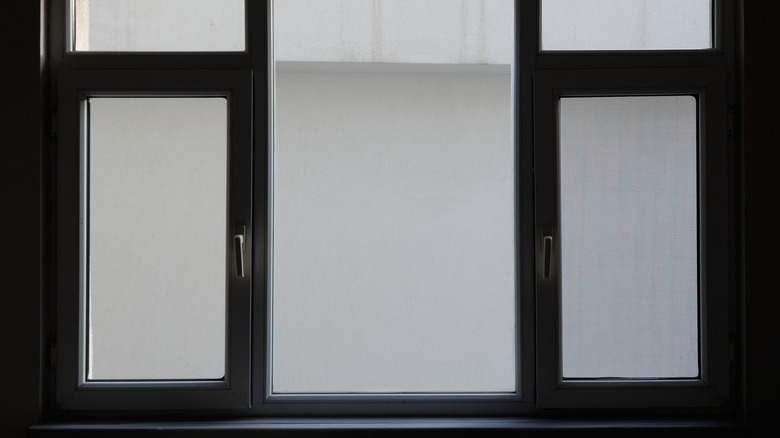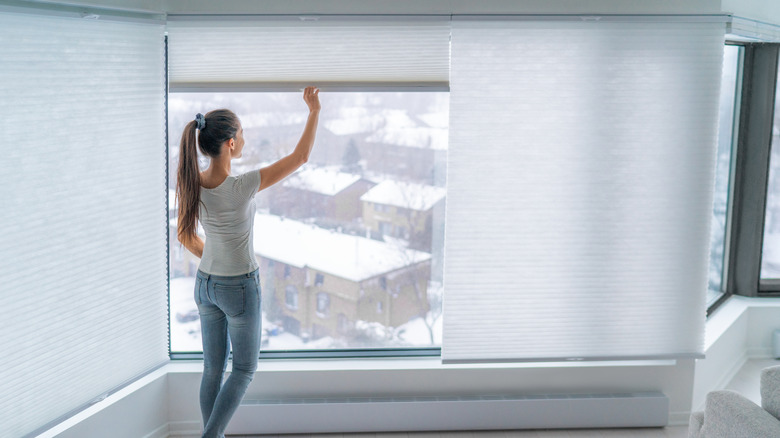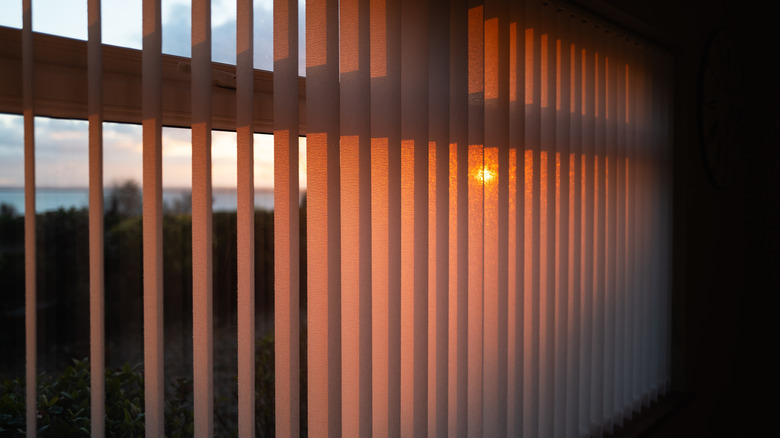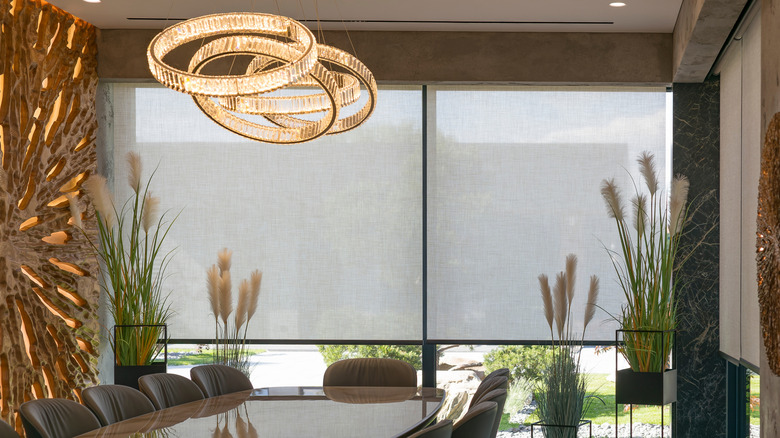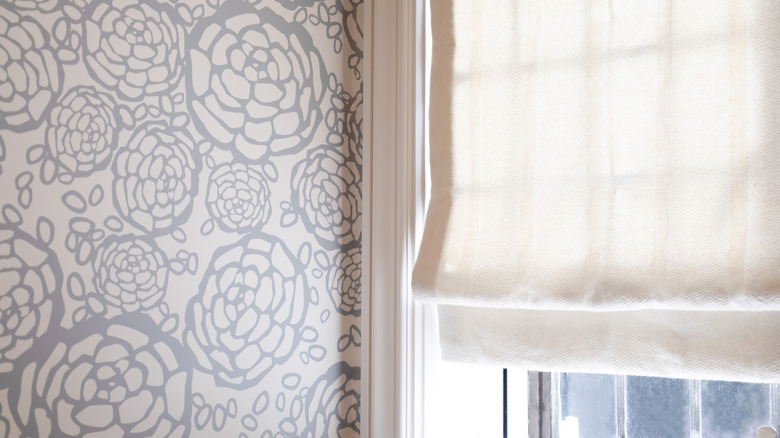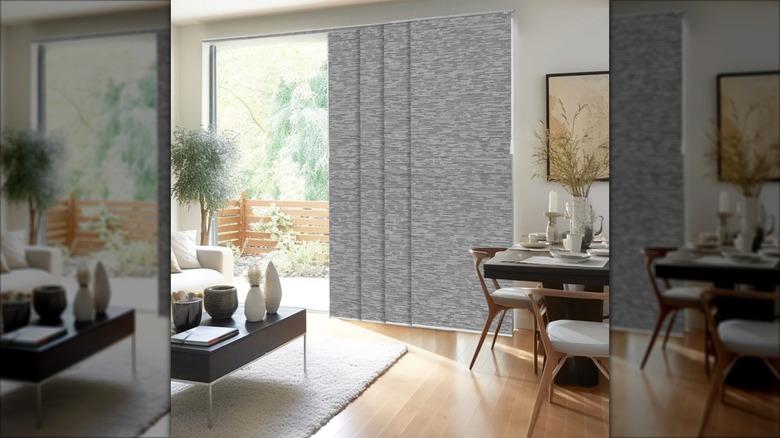10 Stylish Ways To Cover Up Your Large Windows
Large windows are often a major selling point in homes, as they create the look of an airy, open space. Once you try to actually live with them, however, you might realize that there is such a thing as too much natural light in your home. A massive wall of glass may provide a fashionable touch in your room, but if you have nosy neighbors, don't want to spend time constantly cleaning, or want to reduce your energy costs at home, it might be time to find a solution that can cover your windows.
Because they take up such a large amount of space, the window coverings you choose matter. Even the most stylish rooms can be completely overshadowed by an overpowering curtain or mismatched blinds. Thankfully, there are plenty of common window treatment types out there, so you're sure to find something that will fit your space. Whether you're looking for a dramatic and glamorous look in the form of extra-large pooling curtains or would rather have a simpler and lower-profile option like motorized blinds, it's possible to choose a window covering that meshes with your room's design, increases privacy, and helps block escaping heat.
Floor-length curtains
If you're looking for a window covering that has nearly infinite options and you're not afraid of a bit of drama, consider installing floor-length curtains. Depending on the size of your windows, this can be one of the more cost-effective options. Look for curtains that skim the floor if you're planning to open and close them frequently or add a few inches of extra length to create a luxe pooling effect. You also have plenty of choice when it comes to material, color, and pattern, so don't be afraid to search until you find something you love.
Roller shades
If you want something that's a bit sleeker and more minimalistic than a traditional curtain, consider going for roller shades. They provide the same level of light reduction and privacy as curtains, but there's much less extra material to deal with. If you're working with standard-size or slightly larger than standard-size windows, you can probably find roller shades that will fit online — just be sure to add a few extra inches to the width if you plan to mount them outside of the window frame. If your windows are especially large, however, it might be more beneficial to go the custom route.
Shutters
Shutters are more commonly found on the exterior of home, but they can make for a great accent indoors, too. They are a suitable option if you're looking for a more permanent solution that feels like it's part of the house. The drawback of this decision is that shutters will likely require professional installation, especially if you're working with very large windows. After you make the initial investment, however, you can rest assured that you'll earn at least some of your money back, both because of shutters' impacts on resale value and their ability to reduce heat loss.
Window film
Sometimes, the look of large windows isn't the problem at all — it's just the lack of privacy or the constant direct sunlight that's a bother. If you still like the design of your windows and want to show them off, you can invest in window film that helps reduce UV rays and block the view from outdoors. There are plenty of different types to choose from — heat-control films, decorative films, anti-glare films, and privacy films, to name a few — but they're typically inexpensive and can be installed yourself if you have patience and a steady hand.
Motorized blinds
One of the biggest issues with having large windows is that parts of them are often inaccessible. High ceilings and grand windows can leave you struggling to reach your coverings when you need to adjust them, but motorized blinds solve this issue. Rather than having to rely on a pull string, you can block light using a remote control or your phone. With more advanced systems, you can even program your blinds to open and close on a set schedule, ensuring that you have the perfect level of natural light throughout the day.
Cellular shades
Heat loss can be a major concern for homeowners with large windows, and one of the best methods to reduce the amount of heat escaping through convection (besides properly sealing any gaps, of course) is investing in cellular shades. Thanks to their unique design, cellular shades create honeycomb-shaped pockets of air that can act as an additional layer of insulation between the glass and the rest of the room. As a bonus, these shades still let a bit of sun in without sacrificing privacy, so you can still enjoy a dose of diffused natural light throughout the day.
Vertical blinds
Floor-to-ceiling windows or glass doors can be particularly difficult to cover, but vertical blinds offer a solution. Unlike regular horizontal blinds, vertical blinds can be fully swept to the side to provide access to the door or window. They're also great if you want to make your room appear taller, as the vertical lines draw the eye upwards. Unfortunately, however, some inexpensive vertical blinds can be noisy or break easily. If you go this route, make sure to handle your blinds gently and choose an option that's made of durable materials for the best longevity.
Solar shades
Even if you decide to cover your windows, you don't have to sacrifice your view completely. Solar shades are a specific type of roller shade that's made of thin, woven material. They still block UV rays and help create more privacy, but the small gaps in the weave allow you to see the view on the other side. There are different levels of transparency to choose from — 1%, for example, blocks 99% of UV rays and is more on the opaque side. Meanwhile, 10% blocks 90% of UV rays and enables you to see more of the view.
Roman shades
Roman shades are the stylistic middle ground between roller shades and curtains. Rather than rolling up to close, they fold, which helps create a more classic and textured look. There are plenty of decisions to make before you settle on your final look, including the fabric type, color, pattern, and whether or not you have a liner, so these shades are easy to customize to your taste and desired light level. If you go the custom-made route (or just choose a basic pattern), you can also mix your curtain styles while still creating a cohesive look with matching fabrics.
Sliding panels
Looking for a window covering that will provide similar functionality to vertical blinds but with an upgraded touch? Consider trying out sliding panels. These blind alternatives also run on a track system, so they're great for spaces where you need full access to a sliding door or floor-to-ceiling window. Unlike blinds, however, they feature larger fabric pieces rather than thin plastic slats. Thanks to this configuration, sliding panels solve many of the issues people have with vertical blinds. They open and close with less noise, aren't as prone to snapping off, and help create a sleek, modern look.

